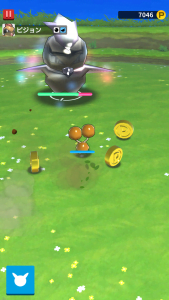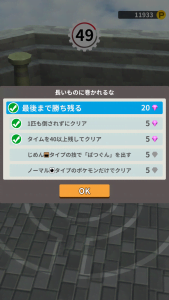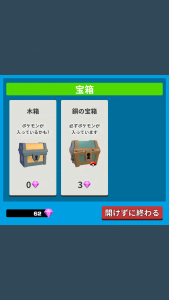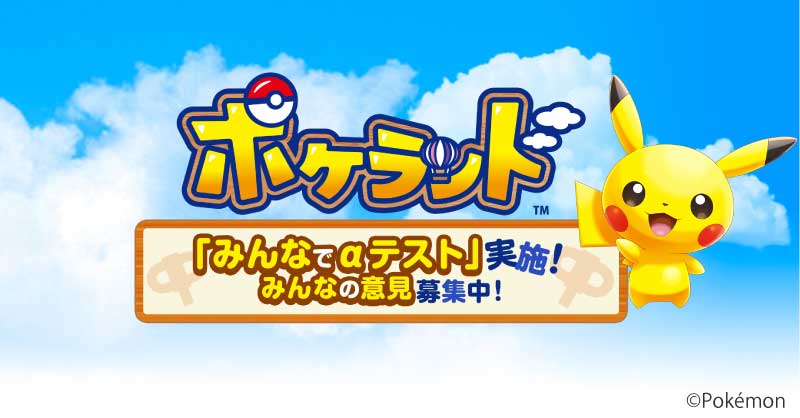PokéLand First Impressions
Me gives us a rundown on his impressions of the Alpha version of the new Pokémon mobile game, PokéLand!
PokéLand, a new mobile phone game and the first on the platform in the Pokémon Rumble series, has just been announced. The game has no worldwide release date, but already has an alpha build available for Japanese fans.
Pokémon Rumble fan Me has already given the game a solid test drive. Check out his impressions of the game below!
Today, out of nowhere, hot on the heels of the recently released Magikarp Jump, and much to my surprise, The Pokémon Company announced yet another smartphone title: PokéLand.
Unlike previous announcements, however, this was not done through the usual brief teaser trailer or a magazine advertisement, but instead an open alpha testing phase through the Japanese Google Play Store! Being an avid Pokéfan and a decently adept smartphone user, I quickly set up a VPN, registered a spare Google account and jumped right into the Japanese store to sign up for the test version!
Overview
 So, after a few hours with it, what’s it like?
So, after a few hours with it, what’s it like?
Well, to keep it short, it’s a simplified Pokémon Rumble World for your smartphone, with a few small signs here and there of the baggage that comes with launching on smart device platforms.
For those not familiar with Pokémon Rumble World, and by extension Pokémon Rumble as a series in general, they are simple character action games with limited RPG elements. You take direct control of super-deformed wind-up Pokémon toys, fighting your way through equally simple dungeons defeating and recruiting other, increasingly more powerful toys. PokéLand is no exception to that definition.
In Pokéland you find yourself in the role of what appears to be an explorer of some kind, represented by your choice from the game’s collection of Nintendo Mii characters (or by your own Mii if you choose to link a Nintendo account to the game). You are tasked by an old man, likely a Pokémon professor, to explore the titular PokéLand in search of toy Pokémon to capture.
And so, equipped with nothing initially but a trusty, perhaps indeed rusty, toy Rattata and a fairly unsafe looking air balloon, you head into the world of PokéLand and the many islands within it.
Dungeons and Battling
Each island consists of several small dungeons where your Rattata, eventually your toy Pokémon of choice, will automatically walk down the dungeon’s linear halls meeting, defeating and capturing an oncoming horde of enemy toys by your commands before finally facing off with a larger, more powerful boss character.
Y ou can order your partner to attack with their single available move by tapping on the screen, and issue a command to dodge enemy attacks (which quite handily telegraph themselves heavily) by flicking in a direction, making your partner nimbly tumble away from damage before hastily returning to the fray. This gives the game a feeling not unlike those of other character action games such as Bayonetta, strategically dodging enemy attacks at the last moment and following up with a string of your own to overcome each of the game’s challenges.
ou can order your partner to attack with their single available move by tapping on the screen, and issue a command to dodge enemy attacks (which quite handily telegraph themselves heavily) by flicking in a direction, making your partner nimbly tumble away from damage before hastily returning to the fray. This gives the game a feeling not unlike those of other character action games such as Bayonetta, strategically dodging enemy attacks at the last moment and following up with a string of your own to overcome each of the game’s challenges.
Bosses are a little bit more complicated than the overly simplistic enemies by having their own distinct patterns and phases to contend with. They will charge powerful attacks, summon minions, defend themselves and frequently and swiftly move around their circular arenas. This makes for far more involved fights as you try to find the best opportunity to sneak in and land blows against them without putting your partner toy in danger.
Being defeated in a dungeon doesn’t come with any harsh penalties should you find this too overwhelming, merely allowing you to change which partner you’re using and sending you back in the dungeon a little.
Progression
Defeated enemies and bosses drop coins, chests and sometimes even fall to the ground and become captured, returning to a ball and allowing themselves to join you on your adventure if you can clear the dungeon you defeat them in.
 Each captured toy is usually stronger than your current selection of toys, and with good reason: as toys, your Pokémon can not gain experience points, nor can they level up, so your new recruits essentially and sometimes unfortunately replace your existing, trusted and well-loved partners to allow you to take on tougher challenges.
Each captured toy is usually stronger than your current selection of toys, and with good reason: as toys, your Pokémon can not gain experience points, nor can they level up, so your new recruits essentially and sometimes unfortunately replace your existing, trusted and well-loved partners to allow you to take on tougher challenges.
Every Pokémon that joins you also gives you a little bit of experience towards your ranking, with capturing a Pokémon species for the first time granting a larger boost, eventually enabling you to take on Battle Royale challenges when you reach certain ranks.
In Battle Royale challenges, three of your partner Pokémon take on a dangerous gauntlet of opponents under a strict time limit, testing both your skill and the power of your partners. The same gameplay rules apply here, so you’ll be dodging attacks from all sides and defeating large groups of enemy toys as you race against the clock.
There’s only one caveat: if your partner falls in battle here, you simply have to try again, no second chances!
Completing a Battle Royale will reward you with diamonds, and clearing certain challenges within the Battle Royale (such as using a super effective move or certain typed Pokémon) will earn you additional diamonds.
Coins, Chests and Diamonds
Diamonds are used for several important features within the game, chief among them being unlocking new islands to explore and new toy Pokémon to recruit, alongside opening chests you might find within dungeons.
Here is where the game begins to show its trappings as a mobile phone title, and here in the alpha test it is too early to tell how crippling these features may be.
Unlocking new islands is a very slow process, requiring hundreds of diamonds. Clearing a dungeon for the first time, and the first time only, will reward you with several diamonds and going up a rank by gaining enough experience will reward you with five additional diamonds per rank level achieved, so you’ll be playing the same few dungeons you have access to over and over again as you work towards earning enough diamonds to open new ones.
 It is possible to gain access to better, one-off dungeons to make this grind a little easier by expending a usage of a radar kept on your air balloon. These dungeons appear to have much better rewards and a higher variety of Pokémon for capture, but it takes a full half hour of real time for your radar to recharge, and it can only store four charges.
It is possible to gain access to better, one-off dungeons to make this grind a little easier by expending a usage of a radar kept on your air balloon. These dungeons appear to have much better rewards and a higher variety of Pokémon for capture, but it takes a full half hour of real time for your radar to recharge, and it can only store four charges.
You can opt to skip this wait, as in most mobile games, by expending in-game currency, which in this case is coins. It costs 2000 coins to recharge your radar by one charge but you typically only gain a few hundred coins per dungeon, making this an even slower grind on top of the existing grind for rank. You can sell captured toys that you no longer require for additional coins, but they tend to be worth very few coins as well.
So, is there really nothing to do until the radar recharges other than grind? This is where the previously mentioned chests come into play. Dropped randomly by opponents in dungeons, chests can contain rare Pokémon and large quantities of coins .
They come in several forms, with boring wooden chests being the bog-standard common variety and increasingly more ornate chests each being rarer than the last. Wooden chests are a wonderful find: they are free to open and usually give useful amounts of coins as a reward (e.g. a few hundred, compared to the few coins a single Pokémon may give).
Note however that I specifically said they are “free to open”, and that word choice was no accident. This is because rarer chests cost diamonds to open. On the flipside they usually contain rare Pokémon and excessively large amounts of coins, often thousands of them, making them a very tempting proposition each and every time you are presented with one. The game even has a store on the main menu to purchase rare chests without having to wait for them to appear in dungeons! As an example, a red chest required 12 diamonds and rewarded me with 20,000 coins, an Attribute+ Tauros, and five gears!
 This unfortunately has the effect of causing a downward spiral in the gameplay loop should you actually choose to utilise them: you grind for experience points to go up a rank and obtain more diamonds, only to spend your coins to gain experience faster, wherein you are tempted to spend your diamonds to speed things up further and then deprive yourself of the very thing you were trying to obtain in the process.
This unfortunately has the effect of causing a downward spiral in the gameplay loop should you actually choose to utilise them: you grind for experience points to go up a rank and obtain more diamonds, only to spend your coins to gain experience faster, wherein you are tempted to spend your diamonds to speed things up further and then deprive yourself of the very thing you were trying to obtain in the process.
It’s perhaps here where I have the biggest misgivings about the game, as diamonds are so hard to come by in the alpha it stunts any feeling of progression you have before you slam into what will inevitably be a paywall in the final version.
Of course it remains to be seen what will change for the final public release, but whilst the game itself is a blast to play and does a wonderful job adapting the Rumble series’ already simple character action game mechanics perfectly into a smartphone title, progression is simply too slow and the paywall arrives far too soon for what I feel the average player will care for. The game does award extra diamonds randomly as other player’s balloons float by on the island menu, but it is not common enough to make up for anything.
In addition, in the alpha there does not appear to be any clear indication of what the monetisation structure will be. With no menu present for the purchase of additional diamonds, some fear remains as to what they will be charging for a more realistic speed of progression.
It is possible that we may be surprised: Pokémon Rumble World claimed itself as a free to play game but instead proved to be a strangely disguised $30 game purchase. History has repeated with the payment limitations found in the recently released Magikarp Jump. It may yet be that those willing to pay won’t find themselves too far out of pocket, with those willing to play the slow waiting game free-to-play is asking for left able to do so.
The Finer Details
There are mechanics that return from the previous Pokémon Rumble titles, such as sparkling Pokémon that have a 100% drop rate when defeated. There are also combos; KOing four Pokémon in one move is a ‘Nice’ combination, and a few more makes a ‘Great’ combo.
Pokémon can have rare Abilities at random. Thus far in this alpha build, Pokémon only have one move, but bosses have used multiple attacks on myself.
It’s technically possible to level Pokémon up here, but the items to do so are freakishly rare. I’ve opened eight or so of the pay-to-open chests and got one of them, a gear that bumped up a Pokémon’s power by a mere 12 points.
It’s also possible to charge moves by holding your finger on the screen, but the damage increase is ridiculously negligible, and leaves yourself wide open to attacks.
Gears appear to be limited in use. At any rate, I can use some on a few Pokémon but not on others. There seems to be a cap on the amount of times a Pokémon can be levelled up. One that was upgraded had a ‘1/2’ next to a gear icon on its stats. Meanwhile my Tauros (not upgraded) had 0/20.
Verdict
Overall, I have some mixed feelings about the alpha for PokéLand, but I remain optimistic; I just had too much fun with the gameplay itself to be totally taken aback by the restrictions on progression. It captures the simple and enjoyable action mechanics from the main line Pokémon Rumble releases and adapts them to a simplified control style quite handily and for that it needs to be commended.
Where it can be argued that a game like Magikarp Jump has no real gameplay to speak of, PokéLand is a legitimately enjoyable action title that plays very smoothly even in its alpha release.
I will admit the looming threat of monetisation and the overly slow grind for progression leaves a somewhat bitter-sweet taste to proceedings. However it is, of course, only an alpha release, so it remains to be seen where PokéLand ultimately succeeds and where it fails, and it’s far too early to tell what problems will plague it and which will resolve before the final version of the game hits the public.
Edited by bobandbill and Zach.
